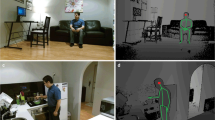The automated care and monitoring of vulnerable people is becoming a reality with the rapid development and improvement of networked sensor technologies. Many researchers have shown considerable success in determining immediate causes for concern in well-being, such as detecting falls in the home. To date however, little emphasis has been placed on monitoring well-being in a long-term sense, known as third generation telecare. The system described in this paper involves a customised sensor network, able to detect a person’s movements and use of furniture and household items, coupled with a sophisticated fuzzy data analysis process able to infer activities that the monitored client is undertaking and thus answer high level queries such as “is the person eating regularly”. The system also detects abnormal patterns of behaviour and provides tools for long-term trend analysis such that gradual and subtle changes in behaviour can be clearly understood. Soft computing techniques are needed due to the high degree of uncertainty in the inference process. We also describe a trial of the system, which was installed in two homes. Results indicate that fuzzy analysis enables us to summarise the data in a manner which is useful to the care providers without them needing to be experts in data analysis.
Access this chapter
Tax calculation will be finalised at checkout
Purchases are for personal use only
Preview
Unable to display preview. Download preview PDF.
Similar content being viewed by others
References
Garner, P., M. Collins, S. M. Webster, and D. A. D. Rose, “The application of telepresence in medicine,” BT Technology Journal, vol. 15, pp. 181-187, 1997.
Haigh, K. Z. and H. A. Yanco, “Automation as Caregiver: A Survey of Issues and Technologies,” presented at Automation as caregiver: the role of intelligent technology in elder care, Edmonton, Canada, 2002.
Barnes, N. M., N. H. Edwards, D. A. D. Rose, and P. Garner, “Lifestyle monitoring - technology for supported independence,” Computing and Control Engineering Journal, vol. 9, pp. 169-174, 1998.
Nelwan, S. P., T. B. van Dam, P. Klootwijk, and S. H. Meij, “Ubiquitous Mobile Access to Real-time Patient Monitoring Data,” presented at Computers in cardiology, Memphis, TN, 2002.
Barlow, J., S. Bayer, and R. Curry, “The design of pilot telecare projects and their integration into mainstream service delivery,” Journal of Telemedicine and Telecare, vol. 9, pp. 1-3, 2003.
Organisation, W. H., “Active Aging: A Policy Framework,” 2002.
Zadeh, L., “Soft Computing and Fuzzy Logic,” IEEE Software, vol. 11, pp. 48, 1994.
Sixsmith, A., N. Hine, S. Brown, and P. Garner, “Monitoring the well-being of older people,” Gerontechnology, vol. 3, pp. 192, 2005.
Neild, I., D. J. Heatley, R. S. Kalawsky, and P. A. Bowman, “Sensor Networks for Continuous Health Monitoring,” BT Technology Journal, vol. 22, pp. 130-139, 2004.
Majeed, B., T. P. Martin, N. P. Clarke, and B.-S. Lee, “Intelligent Data Analysis for Well-Being Monitoring,” presented at Perspectives in Pervasive Computing, London, 2005.
Lee, B.-S., T. P. Martin, N. P. Clarke, and B. Majeed, “Dynamic Daily-living Pattern and Association Analysis in Tele-care System,” presented at Fourth IEEE International Conference on Data Mining, Brighton, UK, 2004.
Brown, S., N. Hine, A. Sixsmith, and P. Garner, “Care in the Community,” BT Technology Journal, vol. 22, pp. 56-64, 2004.
Author information
Authors and Affiliations
Editor information
Editors and Affiliations
Rights and permissions
Copyright information
© 2007 Springer-Verlag Berlin Heidelberg
About this chapter
Cite this chapter
Martin, T., Majeed, B., Lee, BS., Clarke, N. (2007). A Third-Generation Telecare System using Fuzzy Ambient Intelligence. In: Lee, R.S.T., Loia, V. (eds) Computational Intelligence for Agent-based Systems. Studies in Computational Intelligence, vol 72. Springer, Berlin, Heidelberg. https://doi.org/10.1007/978-3-540-73177-1_6
Download citation
DOI: https://doi.org/10.1007/978-3-540-73177-1_6
Publisher Name: Springer, Berlin, Heidelberg
Print ISBN: 978-3-540-73175-7
Online ISBN: 978-3-540-73177-1
eBook Packages: EngineeringEngineering (R0)




